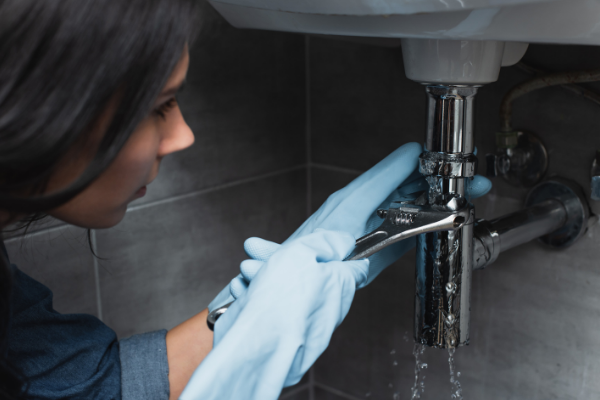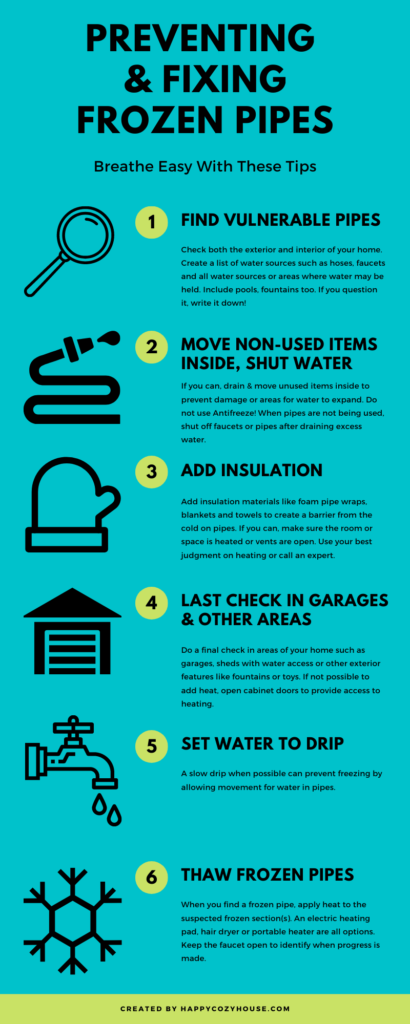Frozen Pipes? What To Do & How To Prevent
Colder weather is here. It means potential for sledding, hot chocolate and other winter activities. It also means the potential for frozen pipes, broken water lines, and massive headaches. Whether you are trying to protect your year-around home, a second vacation house or a family member’s home, we have gathered information to help with just about any situation. As always, there is no guarantee of any information below. If you have questions or concerns, we recommend hiring an expert or calling your insurance company for guidance and suggestions.
Frozen Pipes: Protecting Your Home
If you plan to be in your home the entire winter, you have a real advantage. Checking your pipes daily and looking for leaks and failure points is a must during the extreme cold of winter when temperatures are below freezing. As water freezes, it expands, causing the dreaded burst pipes. Preventing pipes from getting cold in the first place will prevent a lot of issues later.
Inspect and do an audit of your home interior and exterior looking for pipes, hoses, water sources and any potential sources where water may be and could freeze. Next, review your list and prioritize risk. Remove any easy sources of freezing such as pool hoses or exterior hoses and store them away. Turn off exterior water faucets where possible. On the inside, if you suspect a pipe could become frozen there are a few considerations. If you won’t use that source, drain the water in the line and turn it off until you will need it again. Another option is to insulate the pipe using simple insulation material you can find at your local hardware store or by wrapping the pipe. The Red Cross has more information on how to protect your pipes.

What To Look For? What Is At Risk?
Homes in areas where there is typically no freezing can be especially vulnerable due to lack of standard insulation or preventing measures. Pipes on exterior walls or near windows, exhaust fans or other exterior openings are also more prone to freezing or exposure to cold temperatures.
Also, the type of pipe makes a difference. Those that are more susceptible according to Bob Villa include “outdoor hose bibs, swimming pool supply lines, water sprinkler lines” as well as interior pipes that are not in warm areas of the home or have heating cut off.
Preparing a 2nd Home: Winter Frozen Pipe Prevention
Many people close up their homes for winter by winterizing a property. Older lake homes may only have electric floorboard heat or a wood burning stove. Neither of these are great options when you are away for long periods of time.
Take time to shut off the water completely and drain the pipes of water. Start from the top level of your home opening faucets in bathrooms, shower and bathtubs and watching the water drain out. Leave these faucets open. Drain the water from your toilet top tank and bowl. You can add plumber’s antifreeze according to DIYNetwork.com. This is a special type of antifreeze and available at your hardware store. Do not use typical antifreeze.
For your drains, add a bit of plumber’s antifreeze here as well to act as the water that typically stands in drains. About a 1/2 cup should do. Lastly, check your water heater, dishwasher, and washing machine. Make sure these are drained completely as well.
Protecting a Family Member’s Home From Frozen or Bursting Pipes
Walking through the steps as you would for your own home will help. However, working with your family member or friend to be diligent and check is important. Call each week or when the temperature drops below freezing and stays there. Create a simple process to walk through their home with them via phone or video chat as they check pipes, faucets and for potential exposure. Even more important is draining unused pipes and hoses to minimize potential opportunities for frozen pipes or bursting pipes damage.
What To Do When A Pipe Freezes?
Act quickly. Turn on the suspect faucet. If only a trickle comes out, you may have a frozen pipe. Adding heat from an electric heating pad, hair dryer or portable space heater will help thaw the pipe. Feeling the pipe may help identify the specific area that is frozen so you can focus there before it damages the pipe. Open the faucet a small bit so you can tell when the frozen water is thawing and water is able to flow freely. Not making progress or unsure if you can fix it yourself? Call a plumber ASAP. Preventing a frozen pipe from becoming a bursting pipe is critical at this point. Do not delay.

Frozen Pipes: Bursting Pipe Prevention and Fixes
Winter is a great time of year, but do not let frozen pipes be a headache. It is better to act with caution and call a plumber or resource if you question anything in your home. An added bit of caution may be to contact your insurance company for resources or to make sure you are covered in case of frozen pipes. Not all insurance covers damage from frozen pipes so if this is of particular concern, verify before hand so there are no surprises. A bursting pipe is critical to prevent and with these tools, diligent checking and a little effort, you can do just this. Have a great winter!

